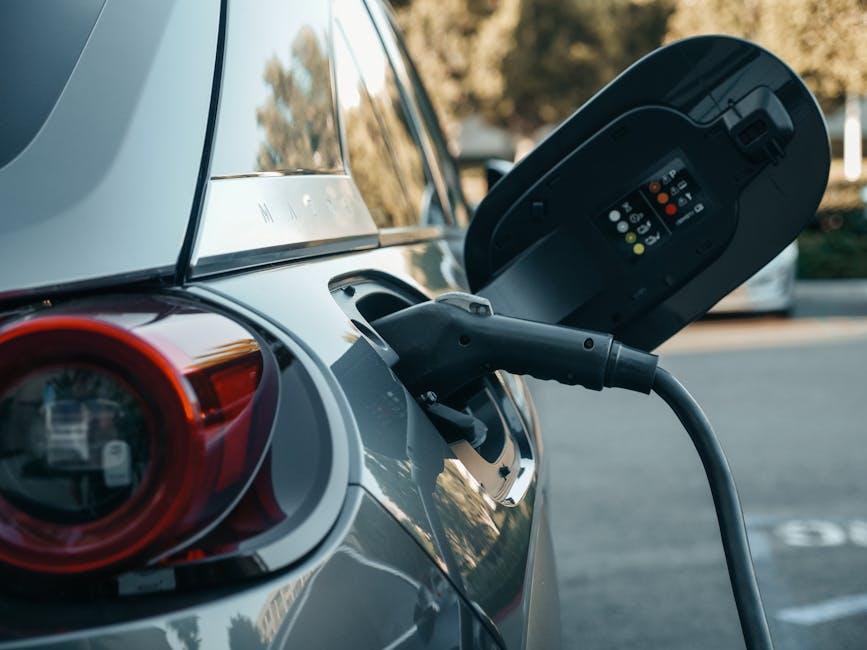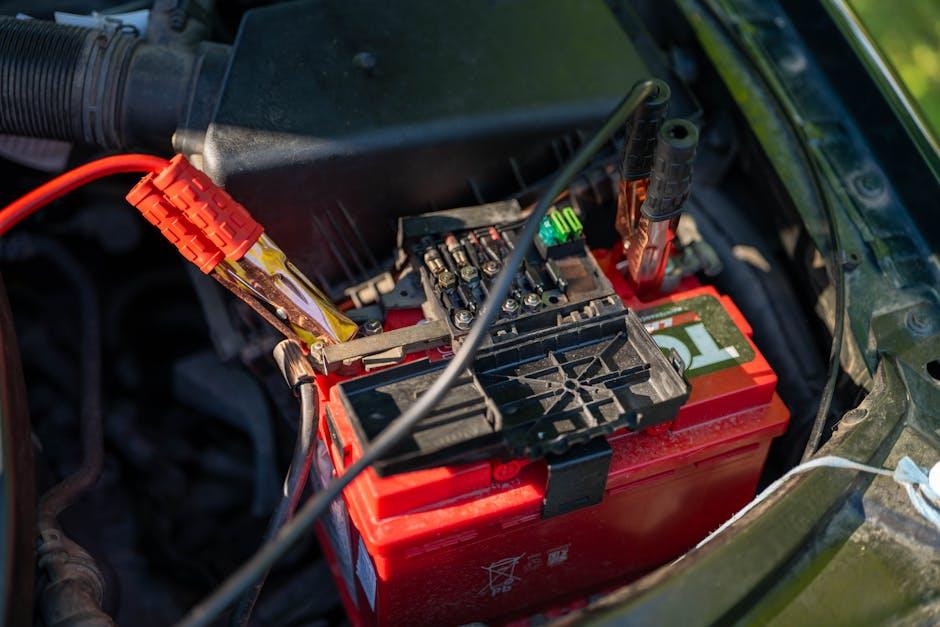Imagine starting your day only to find your car won’t roar to life — a silent reminder that your battery might be waving a few warning signs. Your car’s battery is the heart of its electrical system, silently powering everything from the ignition to the dashboard lights. But how can you tell when this vital component is losing its charge or nearing the end of its life without stepping into a mechanic’s garage? Fortunately, checking your car battery’s health at home is easier than you might think. In this guide, we’ll explore simple and effective ways to assess your battery’s condition, helping you stay ahead of unexpected breakdowns and keep your vehicle running smoothly.
Table of Contents
- Understanding the Basics of Car Battery Health
- Tools Needed for Effective At-Home Battery Testing
- Visual Inspection Tips for Early Battery Trouble Signs
- Step-by-Step Guide to Using a Multimeter on Your Battery
- Interpreting Voltage Readings and What They Mean
- Maintenance Practices to Extend Your Battery’s Lifespan
- Q&A
- The Conclusion

Understanding the Basics of Car Battery Health
Keeping your car battery in prime condition is essential for reliable starts and optimal vehicle performance. At its core, a car battery stores electrical energy and supplies power to start the engine and run accessories. Over time, however, factors like temperature fluctuations, frequent short trips, and age can diminish its ability to hold a charge. Understanding the basic signs of battery health involves observing voltage levels, checking for physical corrosion on terminals, and recognizing the warning symptoms of a weakening battery, such as slow engine cranking or dim headlights.
Regular home checks can extend the life of your battery and help you anticipate replacement needs before emergencies strike. Tools like a digital multimeter are invaluable for measuring voltage, where a healthy battery typically reads between 12.6 to 12.8 volts when fully charged. Additionally, a visual inspection can reveal corrosion deposits or damaged cables, both of which hinder electrical flow. Below is a quick reference table for interpreting battery voltage readings at rest:
| Voltage | Battery Health Status |
|---|---|
| 12.6 – 12.8 V | Fully Charged & Healthy |
| 12.4 – 12.6 V | Moderate Charge – Check Soon |
| < 12.4 V | Low Charge – Recharge or Replace |
- Inspect terminals: Clean off corrosion with a mixture of baking soda and water.
- Test voltage: Use a voltmeter or multimeter to verify charge levels.
- Monitor performance: Note how the vehicle starts and if electrical components behave oddly.

Tools Needed for Effective At-Home Battery Testing
Before diving into the process, it’s essential to gather the right gear that ensures accurate and safe battery testing. Among the essentials, a multimeter stands out as the most versatile tool, allowing you to measure voltage, current, and resistance quickly. For enthusiasts seeking a deeper insight, a battery load tester provides a realistic simulation of engine cranking, revealing the battery’s ability to perform under stress. Don’t forget protective gear like insulated gloves and safety glasses — safety should always come first when handling automotive batteries.
In addition to these, having a few handy accessories can make your testing more efficient and less messy. Keep a set of battery terminal cleaners to remove any corrosion, ensuring that your connections are spot on. A simple battery hydrometer can help test the electrolyte’s specific gravity in traditional lead-acid batteries, giving a clear indication of the battery’s health state. Here’s a quick overview to help you organize your toolkit:
| Tool | Purpose |
|---|---|
| Multimeter | Measures voltage and overall battery health |
| Load Tester | Simulates engine start load to test battery under stress |
| Battery Hydrometer | Checks electrolyte specific gravity in acid batteries |
| Terminal Cleaner | Removes corrosion for better connections |
| Safety Gloves & Glasses | Protects from acid and electrical hazards |

Visual Inspection Tips for Early Battery Trouble Signs
Begin your inspection by examining the battery case for any signs of damage or swelling. A slightly bloated or cracked battery shell can indicate internal issues, often caused by overheating or gas buildup, which compromises performance and safety. Keep an eye out for corrosion around the terminals, usually a white or greenish powder that can impede electrical flow and reduce battery efficiency. Cleaning this buildup gently with a mixture of baking soda and water can help maintain good contact, but persistent corrosion may signal an underlying problem needing attention.
Also, check for any loose or frayed connecting cables that might disrupt the electrical circuit. Pay attention to the battery’s color-coded indicator if available—a green or blue dot generally means the battery is in good health, while yellow or red often signals trouble. To visualize, here’s a quick reference for common visual cues:
| Visual Sign | What it Means | Recommended Action |
|---|---|---|
| Battery swelling | Internal damage or overheating | Immediate replacement |
| Terminal corrosion | Impeded electrical connection | Clean terminals & inspect cables |
| Discolored indicator | Battery charge status | Further testing advised |

Step-by-Step Guide to Using a Multimeter on Your Battery
Begin by ensuring your vehicle is off and the keys are removed from the ignition. Locate the battery under the hood and visually inspect it for any corrosion or damage. Next, grab your multimeter and set it to measure voltage (usually indicated by “V” with a straight line for DC voltage). Attach the red probe to the positive terminal and the black probe to the negative terminal. A healthy, fully charged car battery should read between 12.6 and 12.8 volts. Readings below 12.4 volts may indicate the battery is partially discharged, while anything under 12 volts is a clear sign your battery needs attention or replacement.
For a quick reference, here’s a simple guide to what your multimeter readings mean:
| Multimeter Reading (Volts) | Battery Health Status |
|---|---|
| 12.6 – 12.8 | Fully charged and healthy |
| 12.4 – 12.6 | Slightly discharged, but generally okay |
| 12.0 – 12.4 | Needs charging soon |
| Below 12.0 | Battery failing or dead |
After testing voltage, you can switch your multimeter to the amperage or resistance mode to check for further diagnostics, but voltage is the quickest and most effective way to evaluate battery health at home. Always remember to wear safety gloves and glasses when handling batteries, as they contain corrosive acid and can deliver a powerful shock if mishandled.

Interpreting Voltage Readings and What They Mean
When you measure your car battery’s voltage with a multimeter, the numbers you see offer valuable insights into its overall condition. A fully charged battery typically reads around 12.6 volts or higher. Values dipping to around 12.4 volts suggest a moderately charged battery, which might still operate effectively but could benefit from a recharge soon. Anything below 12.0 volts generally indicates a significantly discharged battery that requires immediate attention, potentially signaling a failing battery or charging system issues.
To help you quickly interpret these readings, refer to the table below that summarizes common voltage levels and their meanings:
| Voltage Range | Battery Condition | Recommended Action |
|---|---|---|
| 12.6 V – 12.8 V | Fully Charged | Normal Use |
| 12.4 V – 12.6 V | Partially Charged | Recharge Soon |
| 12.0 V – 12.4 V | Low Charge | Recharge Immediately |
| Below 12.0 V | Discharged or Faulty | Test and Possibly Replace |
Keep in mind that voltage readings should be taken when the engine is off and the battery has rested for at least a few hours to get the most accurate picture. Additionally, a voltage within normal range doesn’t always guarantee a healthy battery—checking for capacity under load can reveal hidden issues that mere voltage cannot detect.

Maintenance Practices to Extend Your Battery’s Lifespan
To maximize the longevity of your car battery, regular upkeep is essential. Start by ensuring the terminals are clean and free of corrosion, as buildup can disrupt electrical flow and reduce efficiency. Use a mixture of baking soda and water with a soft brush to gently scrub off any deposits. Additionally, keep an eye on the battery casing for any signs of damage or swelling, which could indicate internal issues. Parking in shaded areas or garages not only protects the battery from extreme temperatures but also minimizes thermal stress, which can degrade battery chemicals over time.
Consistent monitoring of your battery’s charge level can prevent unexpected failures. Consider the following maintenance tips for optimal performance:
- Check electrolyte levels: For non-sealed batteries, top off with distilled water when necessary to maintain balance.
- Avoid short trips: Frequent short drives don’t allow your alternator enough time to fully recharge the battery.
- Secure connections: Tighten clamps and ensure all cables are firmly attached to prevent voltage drops.
- Use a battery maintainer: When the vehicle is not in use for long periods, these devices help keep the battery charged without overcharging.
| Maintenance Task | Frequency | Benefits |
|---|---|---|
| Clean terminals | Every 3 months | Improves electrical contact |
| Check electrolyte levels | Monthly (if applicable) | Prevents battery drying out |
| Charge battery fully | As needed | Extends cycle life |
| Inspect battery casing | Every 6 months | Detects physical damage early |
Q&A
Q&A: How to Check Car Battery Health at Home
Q1: Why is it important to check my car battery health?
A1: Your car battery is the electrical heart of your vehicle, powering everything from the starter motor to your lights and infotainment system. Regularly checking its health helps prevent unexpected breakdowns and extends the battery’s lifespan.
Q2: What signs indicate my car battery might be failing?
A2: Common warning signs include slow engine crank when starting, dim headlights, the check engine light illuminating, and corrosion around battery terminals. If your car struggles to start or electronics act sluggish, it’s a clue your battery could be on the decline.
Q3: Do I need special tools to check my car battery at home?
A3: You can perform basic checks with no tools at all! For a more accurate health check, a digital multimeter or a battery tester (available at most auto stores) comes in handy.
Q4: How can I visually inspect my battery?
A4: Start by looking for corrosion—white, ashy deposits—on the terminals. Ensure the battery casing isn’t cracked or swollen. Also, check that the battery is securely fastened to avoid vibrations that can cause damage.
Q5: How do I use a multimeter to test my battery voltage?
A5: Set your multimeter to DC voltage (20V range). Connect the red probe to the positive terminal and black probe to the negative terminal. A healthy, fully charged battery should read around 12.6 volts or higher when the car is off. Anything below 12.4 volts signals some level of discharge.
Q6: What’s a quick “jump start” test I can try?
A6: Turn on the headlights without starting the engine. Note their brightness, then try to start the car. If the headlights dim dramatically or the engine cranks slowly, the battery may be weak.
Q7: Can temperature affect battery health readings?
A7: Absolutely. Cold weather reduces battery efficiency and voltage readings. Take this into account if you’re testing on a chilly morning—the battery might read slightly lower than usual.
Q8: What should I do if I find my battery voltage is low?
A8: Try charging the battery fully with a home charger if you have one. If the battery doesn’t hold charge or voltage drops quickly, it’s time for a replacement.
Q9: Is it safe to perform these checks on my own?
A9: Yes, with caution. Avoid sparks and open flames near the battery, wear safety glasses, and handle terminals carefully. If you’re unsure, seeking professional assistance is always wise.
Q10: How often should I check my car battery health at home?
A10: Ideally, check your battery every 3-6 months, especially before winter or long trips. Regular monitoring keeps surprises at bay and your car ready to roll.
The Conclusion
Checking your car battery’s health at home doesn’t have to be a mystery wrapped in a hood. With a little know-how and some simple tools, you can take charge of your vehicle’s power source—catching problems early and saving yourself from unexpected roadside surprises. Remember, a healthy battery is the heart of a reliable ride, so making this quick check a regular habit keeps you confidently on the road. Whether you’re a seasoned gearhead or a curious beginner, these steps empower you to drive smarter and stay prepared—because sometimes, the biggest breakthroughs start with the smallest checks.


34 Comments
https://shorturl.fm/y2EYO
https://shorturl.fm/sEBnq
https://shorturl.fm/AX4ng
https://shorturl.fm/Kr911
https://shorturl.fm/hsTtw
https://shorturl.fm/RdxEV
https://shorturl.fm/2PD9Q
https://shorturl.fm/q6QJ9
https://shorturl.fm/CeNxK
p42gwa
https://shorturl.fm/dKXYY
https://shorturl.fm/Z2SCK
https://shorturl.fm/yqMS5
https://shorturl.fm/juYgM
https://shorturl.fm/L7bnt
https://shorturl.fm/NSthv
https://shorturl.fm/TTJ7a
https://shorturl.fm/kclSg
https://shorturl.fm/ULVjD
https://shorturl.fm/E930d
https://shorturl.fm/AvuoS
https://shorturl.fm/RP9ex
https://shorturl.fm/2PHqQ
https://shorturl.fm/PMpo3
https://shorturl.fm/VeO6j
mg20zk
https://shorturl.fm/M8Ul5
https://shorturl.fm/EWMIa
https://shorturl.fm/9VaeT
f7lvee
https://shorturl.fm/ekD45
https://shorturl.fm/zc8Nv
https://shorturl.fm/Amn3c
https://shorturl.fm/YIL4b